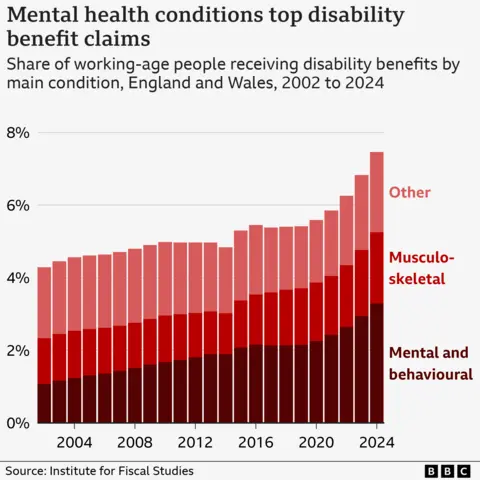 Getty Images
Getty ImagesThe government is considering changes in the benefit of a significant disability called Personal Freedom (PIP) as it seeks to reduce welfare costs.
PIP is paid to people who have difficulty completing or coming around everyday tasks as a result of a long -term physical or mental health condition.
The Sir Career star is facing pressure from some MPs and charities, who say that if the qualifying rules are tightened or changes in payments, weak people can lose.
How much does a pipe cost?
There are two elements for Pup. A daily ingredient and component of movement. Claimers can be eligible for one or both.
In daily life, these fields are covered such as preparing food, washing, reading and management of their money. The movement factor involves physically rotating or getting out of your home.
For each, there are two types of payment – standard and, for those who have the most requirements.
For daily life:
- The standard rate is $ 72.65 per week
- Rising rate is £ 108.55 per week
For the movements:
- Standard rate every week. Is 28.70
- Rising rate is $ 75.75 per week
PIP is usually paid every four weeks and is tax -free.
This does not change in terms of your income and does not take place in revenue that affects other benefits, or Benefit hat. If you are working, you can get PIP.
The payment is made for a fixed period between one and 10 years, after which it is reviewed. A review may come before Your conditions change.
How many people receive PIP and who qualifies?
Currently, more than 3.6 million people claim PIP.
The payment has been made in England, Wales and Northern Ireland. In Scotland, there is one but a separate benefit called adult disability payment.
The contenders are estimated and scored for how much help is needed for every series of daily life and movement, in the process that has given rise to considerable debate and conflict.
The score between eight and 11 leads to a standard rate payment. Improved rates are paid to people with scores 12 and above.
Now approximately 1.3 million people claim the disability benefits Mainly for mental health or behavioral conditions Like Adhd. According to the Institute for Financial Studies (IFS), this accounts for 44 % of all working contenders.

How can the rules be changed?
When the PIP was introduced in 2013, the purpose was to reduce the number of people eligible to pay $ 1.4 billion a year.
However, the initial savings were modest and the number of contenders has increased.
Pip is now the second largest factor in the Working Age Welfare Bill, which will be expected to be about $ 34 34 billion.
Overall, the government currently spends $ 65 billion a year on health and disability benefits. It is likely to grow up to 100bn by 2029.
As a result, there is a pressure from ministers to make changes and encourage people to work.
Initially, it was thought that they might not be able to increase PIP payments for a year – but it is believed that Labor MPs had withdrawn the idea after expressing opposition.
Another option would be to tighten the quality by changing the scoring system for qualifying.

What about options with other benefits?
Although most of the focus is on PIP, the government can decide to change other benefits.
Universal Credit is the biggest benefit of working, which is given to 7.5 million people who can be at work or not.
There is no need for more than 3 million recipients of Universal Credit, the number that has increased rapidly.
The government says it is unstable and wants to provide more people with jobs.



